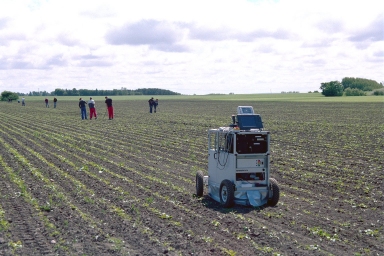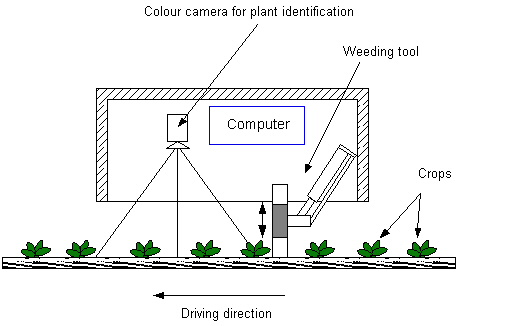MECHWEED
Contents
- 1 VISION-GUIDED MECHANICAL WEED-CONTROL
- 2 Introduction
- 3 Robust and cost-effective automation of mechanical weed control for the cultivation of organic grown sugar beets
- 4 Sponsors
- 5 Previous Projects
- 6 Project members
- 7 Contact
- 8 Partners:
- 9 Awards and Nominations:
- 10 Publications:
- 11 Mass Media Publications:
VISION-GUIDED MECHANICAL WEED-CONTROL
Introduction
The world-wide problem of environmental pollution caused by excessive use of herbicides and the increasing cost of chemicals call for alternative methods for crop protection. A potential way to reduce chemicals is to employ precision techniques for various types of agricultural operations so that chemicals can be used where they have an optimal effect at a minimum quantity. It will even be possible in some operations to abandon the use of chemicals and apply other methods, e.g. mechanical weed control. There is political interest in the European Union in increasing the amount of ecologically grown products. The goal is that about 5-10% of the total field area should be processed by organic farming methods by the year 2005. Organic farming is not only a political goal; there is also a push from the market. More and more customers are asking for products that are organically grown. This has led to a problem for companies that need to increase their supplies of organically grown products to meet customer demands. For example, it is difficult to extend the amount of organically grown sugar beets at the present because weed control in the seed line of sugar beets is done by human labour, which implies high costs and difficulties in recruiting workers. The motivation for the work reported here is to reduce the amount of herbicides used for crop protection in agriculture by replacing chemical weed control by mechanical weed control. The elimination of chemical weed control is one of the requirements for a crop’s being "ecologically grown".
Robust and cost-effective automation of mechanical weed control for the cultivation of organic grown sugar beets
Development of our previously developed methods for plant recognition for handle in-field and between-field variations, i.e. variations of plant properties (size, shape, color) and weed pressure. Research and development of a module for weed control that includes the weeding-tool and a plant identification system. The module could be attached to a row-cultivator or applied on a agricultural robot. A key component is the development of a special designed computer vision system that is cost-effective and powerful enough for the application. Status Our algorithms for plant identification has been implemented on a weeding-robot and tested under real field conditions. The method is sufficiently fast and robust for real-time control of intra-row weed-tool performing intra-row cultivation, able to identify 99% of the crops and remove about half of the intra-row weeds. Video - Field trials summer 2004 A video from a trial (16Mb) or (74Mb).
Sponsors
The project is currently sponsored by SJV, Swedish Board of Agriculture, and SLF, Stiftelsen Lantbruksforskning – the Swedish Farmers’ Foundation for Agricultural Research.
Previous Projects
· Vision-guided mechanical weed control sponsored by the Swedish foundation Stiftelsen för Kunskaps och Kompetensutveckling (Knowledge Foundation) with 829 KSEK for the year 1997.
· Vision-guided mechanical weed control - Part II of the project is supported by the Swedish foundation Stiftelsen för Kunskaps och Kompetensutveckling (Knowledge Foundation) with 1.4 MSEK for a two-year period1998 and 1999.
· Automation of mechanical weed control was sponsored by FORMAS: The Swedish Research Council for Environment, Agricultural Sciences and Spatial Planning with 1.04 MSEK for a three-years period 2001-2003 (In 2001 it was sponsored by SJFR, Skogs- och Jordbrukets Forskningsråd but this is today a part of FORMAS)
Project members
Research Eng. Tommy Salomonsson, Halmstad University Ph.D. Student Björn Åstrand, Halmstad University Ph.D. Student Stefan Ericsson, University of Skövde Ph.D. Student Maria Johansson, Halmstad University Timmy Brolin, Halmstad University
Contact
Björn Åstrand
Partners:
Danisco Sugar AB, SBU- Sockernäringens BetodlingsUtveckling AB, Hushållningsällskapet i Halland, Hushållningsällskapet i Kristianstad.
Awards and Nominations:
Nominated by the KK-foundation and Halmstad University för the - Nytekniks's IT forskningspris -"Framsteget" with the project "Vision Guided Mechanical Weed control" in 1999.
Awardwd in a national Swedish contest "Miljöinovation" 2002 for an autonomout weeding robot. Third price.
The computer-vision system for plant-identification is nominated for the "Student Embedded Award"
Publications:
Thesis
· B. Åstrand, Mechatronics in Agriculture – Row Guidance System for Agricultural Field Machinery (Licentiate thesis), School of Electrical and Computer Engineering, Chalmers University of Technology, Göteborg, Technical Report No. 351L, (2000).
Scientific Journal publications
· Åstrand B., Baerveldt A.-J., An Agricultural Mobile Robot with Vision-Based Perception for Mechanical Weed Control, Autonomous Robots, 13, pp. 21-35, (2002).
· Baerveldt A.J.: Guest Editorial: Agricultural Robotics, Autonomous Robots Vol. 13 Nr. 1, pp. 5-7, Kluwer, July (2002).
· B. Åstrand , Baerveldt A.-J, A mobile robot for mechanical weed control, International Sugar Journal, Vol. 105, No. 1250, February, pp. 89-95, (2003). Invited Paper
· Åstrand B., Baerveldt A.-J., A Vision Based Row-Following System for Agricultural Field Machinery, Mechatronics,15, pp.251-269, (2005).
Conferences and Workshops with full-paper review
· Åstrand B., Baerveldt A. -J., Design of an Agricultural Mobile Robot for Mechanical Weed Control, Proceedings of the Fourth European Workshop on Advanced Mobile Robots (Eurobot'01), Lund, , September 19-21, pp. 139-146, (2001).
· Åstrand B., Baerveldt A. -J., Plant recognition and localization using context information, Mechatronics and Robotics 2004 – special session Autonomous Machines in Agriculture, Aachen, Germany, September 13-15, pp.1191-1196, (2004).
· Johansson M., Søgaard, H. T., Baerveldt A. -J., Robustness of Plant Recognition Based on Active Shape Models, Mechatronics and Robotics 2004 – special session Autonomous Machines in Agriculture, Aachen, Germany, September 13-15, pp. 1185-1190, (2004).
Conferences and Workshops with other scientific review
· Åstrand B., Baerveldt A.-J., Mechatronics in Agriculture - robust recognition of plant rows, The 2nd International Conferance on Recent Advances in Mechatronics, ICRAM'99, Istanbul, Turkey, May 24-26, pp. 135-141, (1999).
· Åstrand B., Baerveldt A.-J., Robust Tracking of Plant Rows using Machine Vision , The Sixth International Conference on Mechatronics and Machine Vision in Practice,1-3 September, Middle East Technical University, Ankara, Turkey, pp. 95-101, (1999).
· Åstrand B., Baerveldt A.-J., A Vision Based Row-Following System for Agricultural Robots, Proceedings of The Symposium on Image Analysis, Swedish Society for Automated Image Analysis (SSAB), Halmstad, Sweden, March 7-8, pp. 113-117, (2000).
· Åstrand B., Baerveldt A.-J., An Agricultural Mobile Robot for Mechanical Weed Control, Computer Image Analysis in Agriculture - Workshop 2002, Bornimer Agrartechnische Berichte, Heft 31, Potsdam-Bornim/Osnabrûck, pp.41-57, (2002).
· Johansson M., Baerveldt A.-J, Segmentation of Partly Occluded Plant Leaves, Swedish Society for Automated Image Analysis (SSBA), pp.77-80, (2005).
Reports
· Ebelin A., Åstrand B., Baerveldt A.-J., Practical use of Image Analysis in Sugar Beet Growing, 63rd IIRB Congress, Interlaken (CH), 9-10 February, (2000).
Mass Media Publications:
- "Genbetorna behövs inte", Hallandsposten, 1997-10-14, (in Swedish).
- "Roboten som inte går bet på betorna", Dagens Industri 1998.
- "Maskin tar hand om ogräset", Hallandsposten, 1998-12-12, (in Swedish).
- UR: Framtidstro - en programserie i tio delar. Del 3: Teknik.


